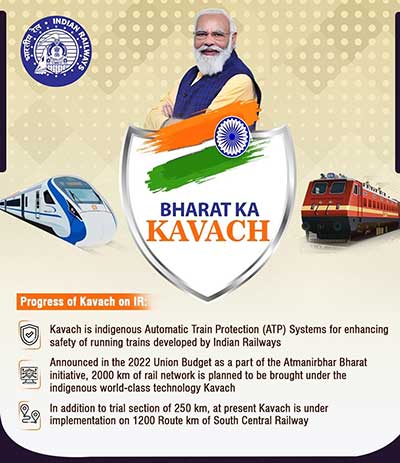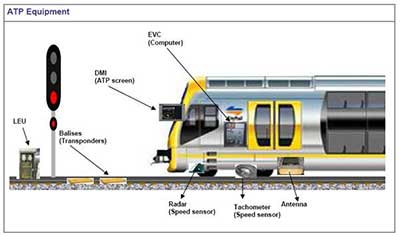Relevance: GS-3: Achievements of Indians in science & technology; indigenization of technology and developing new technology.
Key phrases: Kavach, Train Collision Avoidance System, Radio Frequency Identification devices, ultra high radio frequencies, SPAD, On-Board Display of Signal Aspect, Research Design and Standards Organisation.
Why in News?
- Railway Minister has announced that ‘Kavach’ System, the anti-collision test conducted by the Indian Railways to check the indigenous developed system to avoid rail accidents is successful. He held an on-site inspection today near Secunderabad.
Context:
- Kavach, the indigenously-developed train collision avoidance system (TCAS), is set for countrywide implementation by taking up 4,000-5,000 km each year following the commissioning of up to 2,000 km this year in the South Central Railway (SCR) zone, said Railways Minister Ashwini Vaishnaw on Friday.
- So far, Kavach has been deployed on over 1,098 km and 65 locomotives in ongoing projects of the South Central Railway. In future it will be implemented on 3000 km of the Delhi-Mumbai and Delhi-Howrah corridors where the tracks and systems are being upgraded to host a top speed of 160 kmph.
- In addition to a trial section of 250 km, at present Kavach is under implementation on 1200 km of South Central Railway, on Bidar-Parli Vaiinath-Parbhani and Manmad-Parbhani-Nanded, Secunderabad-Gadwal-Dhone-Guntakal sections.
- Further, over 34,000 km on the High Density Network (HDN) and Highly Utilized Network (HUN) of on the Golden Quadrilateral have been included in its sanctioned plans. Four years ago, Prime Minister Narendra Modi had turned down an ambitious plan of the Railways to roll out ETCS-Level 2 system across its network and had asked the transporter to look for indigenous, cheaper solutions for such future upgrade.
What is Kavach?
- It is a technology designed to bring a train to a halt automatically when it notices another train on the same line within a prescribed distance.
- It is India’s very own automatic protection system in development since 2012, under the name Train Collision Avoidance System (TCAS), which got rechristened to Kavach or “armour”.
- Kavach is developed by Research Design and Standards Organisation (RDSO) in collaboration with Indian industry.
- Simply put, it is a set of electronic devices and Radio Frequency Identification devices installed in locomotives, in the signalling system as well the tracks, that talk to each other using ultra high radio frequencies to control the brakes of trains and also alert drivers, all based on the logic programmed into them.
- One of its features is that by continuously refreshing the movement information of a train, it is able to send out triggers when a loco pilot jumps signal, called Signal Passed at Danger (SPAD), a grave offence in railway operations with respect to safety, and the key to accidents like collision. The devices also continuously relay the signals ahead to the locomotive, making it useful for loco pilots in low visibility, especially during dense fog.
- Trains will also stop on their own when digital system notices any manual error like "jumping" of the red signal or any other malfunction.
- TCAS or Kavach includes the key elements from already existing, and tried and tested systems like the European Train Protection and Warning System, and the indigenous Anti Collison Device. It will also carry features of the high-tech European Train Control System Level-2 in future. The current form of Kavach adheres to the highest level of safety and reliability standard called Safety Integrity Level 4.
- The 'On-Board Display of Signal Aspect' (OBDSA) is to help loco pilots check signals on board consoles. RFID tags are provided on the tracks and at station yard for each track and signals for track identification, location of trains and identification of train direction.
- Once the system is activated, all trains within a 5-km range will halt to provide protection for trains on adjacent tracks. Currently, loco-pilots or assistant loco-pilots usually crane their necks out of the window to look out for caution signs and signals.
- It also includes stationary equipment to gather signaling and loco inputs and relay them to a central system for seamless communication with the train crew and stations.

What is Automatic Train Protection?
- Automatic Train Protection (ATP) is a safety system which continuously monitors the train performance and speed, and applies the brakes if an unsafe situation should arise, a train is going too fast.
- It will also apply the brakes to stop a train if it passes a stop signal.
How does it work?
- The ATP system includes equipment on track and on trains, which interact to help ensure that trains stay at safe speeds.
- This system receives information that allows it to calculate a safe speed and the need for any braking. It then displays this information to the Driver. If the train approaches a potentially unsafe situation, it will apply the train's brakes.
Way forward:
- Announced in the 2022 union Budget as a part of the Atmanirbhar Bharat initiative, 2,000 km of rail network is planned to be brought under the indigenous world-class technology Kavach’, for safety and capacity augmentation in 2022-23.
- In the new avatar, India wants to position Kavach as an exportable system, a cheaper alternative to the European systems in vogue across the world. While now Kavach uses Ultra High Frequency, work is on to make it compatible with 4G Long Term Evolution (LTE) technology and make the product for global markets.
- Work is on to make the system such that it can be compatible with other already installed systems globally. The Research Designs and Standards Organisation (RDSO) in Lucknow along with private vendors are developing the system.
- India wants more private players to take up the development and subseauent production. Once rolled out, it may be world’s cheapest Automatic Train Protection System with the cost of rollout pegged at around Rs 30 lakh to 50 lakh per kilometer, a fourth of the cost of equivalent systems globally.
- In the next phase, the Kavach system will also be able to recalibrate as per temporary speed restrictions en route, something the system does not yet have.
Source: News On Air
Mains Question:
Q. Recent accident of the Bikaner-Guwahati Express on January 13, 2022, brought the importance of Anti-collision device ‘Kavach’ in India. Discuss the role of Anti-collision device ‘Kavach’ to prevent train accidents in India. Critically Analyse.








